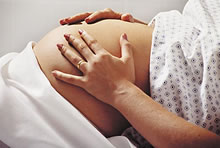Prenatal Massage
- Category: News, Obstetrics & Gynecology
- Posted On:
Alleviate physical and psychological stressors of pregnancy
Kayla Gary, a massage therapist at East Jefferson General Hospital Wellness Center (3726 Houma Blvd., Metairie, 849-6868; ejgh.org), is the kind of person who inspires a sense of calm. Even without knowing she has 17 years of massage therapy and seven years of pre-and perinatal experience, nervous moms-to-be can sense they are in good hands upon meeting Gary.

However, a calming demeanor isn’t the only attribute an expecting mother should look for in her massage therapist. Prenatal massage can yield benefits (including alleviating swelling and joint pain, easing the pains of labor, and reducing anxiety and stress), but there are risks, like stretched ligaments or premature labor, if massage is improperly administered. Prenatal massage therapists must have specialized knowledge of the pregnant form and a thorough understanding of which massage techniques are beneficial and which may be harmful. In Louisiana, therapists attain a prenatal massage certification in order to practice. Gary also suggests that before they make a decision about which therapist to use, potential clients learn how long the therapist has been practicing, how long he or she has specialized in prenatal massage, and what his or her philosophy is on positioning during the massage.
The position in which a pregnant woman is massaged plays a pivotal role in the safety and comfort of the experience. Although some therapists use a massage table that includes cutouts for the belly, breasts, and face, lying prone can be uncomfortable. Allowing the belly to hang through a hole in the massage table can stretch out ligaments, which, unlike muscles, do not re-form to their previous shape. The weight of a hanging belly also can put undue strain on an already stressed lower back. In addition, women in their second trimester and beyond are discouraged from lying on their backs, because the uterus’ weight can inhibit blood flow to the heart and fetus, lowering circulation and reducing the baby’s oxygen intake.
The solution that Gary and many massage therapists employ is designed to protect and relax both mother and fetus. To work on the front side of the body, Gary creates a wedge of pillows that lifts the head and torso to about a 45-degree angle and slips another wedge beneath the knees. In order to massage back muscles, she gently turns her clients on their sides and uses pillows to support the head, neck, belly, and legs. These positions eliminate the strain, worry, and any potential harm.
Although some caution must be used when giving and receiving a prenatal massage (massaging certain areas can stimulate the uterus and cause premature labor, for example), the benefits can be vast. According to a study published in the Journal of Psychosomatic Obstetrics and Gynecology, depressed women who received massage during their second trimester reported lower anxiety, less pain, and better moods than depressed women who did not receive massage. In addition, those receiving massage had reduced levels of the stress hormone norepinephrine.
The same types of results have been reported for women who were experiencing otherwise normal and happy pregnancies. In another study, it was found that women receiving massage during pregnancy had increased levels of serotonin and dopamine, chemicals known to elevate mood, and decreased levels of cortisol, which is associated with stress. “Because prenatal massage is so nurturing and stress-reducing, when a woman goes into labor, her baseline of stress is already lower, so the peak anxiety during labor remains relatively low,” Gary says.
Prenatal massage also helps ease many of the typical physical complaints of pregnant women. A few massages during the second and third trimesters can increase range of motion, reduce swelling, relieve joint pain, reduce leg cramps and back pain, increase blood flow and circulation, alleviate headaches and sinus congestion and even ease the labor experience. Massage by a pre-and postnatal certified therapist also can be used postpartum to help speed recovery, shrink the uterus and speed fluid reduction.
Although not all therapists require it, Gary asks that clients obtain a physician’s release before they come in. “I can communicate with my client and her physician as much or as little as she needs,” Gary says. Communication is key, especially since pregnancy brings up an abundance of emotions. For that reason, Gary speaks with each client before scheduling a massage. Gary also makes sure to keep the lines of communication open during the massage so expectant mothers feel comfortable speaking up if an area is sensitive or needs additional attention.
Many families view prenatal massage as an indulgence they cannot afford, but another way to look at it might be as part of a healthy, preventative care routine — much like exercise and proper diet. Stress and pain have long been identified as factors in lowered immune systems and slow recovery times, so any reduction of these culprits can only be positive for the health of the mother and developing fetus. “I tell my clients that massage is not selfish,” Gary says. “It’s self-care.”